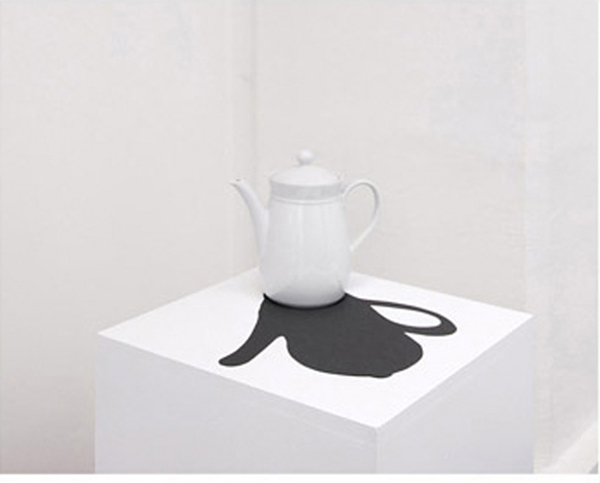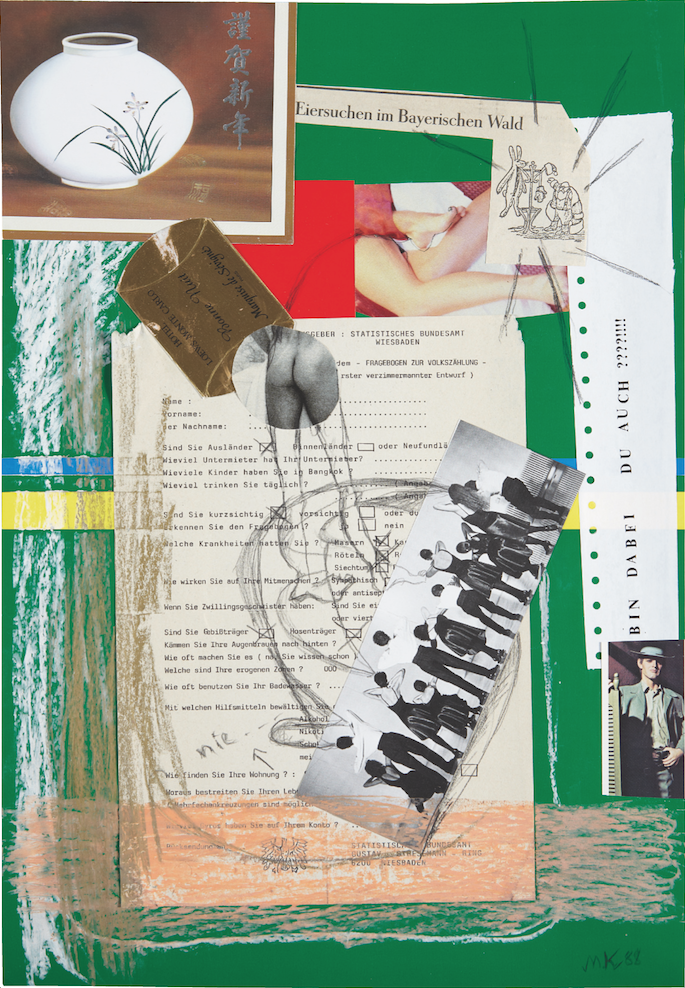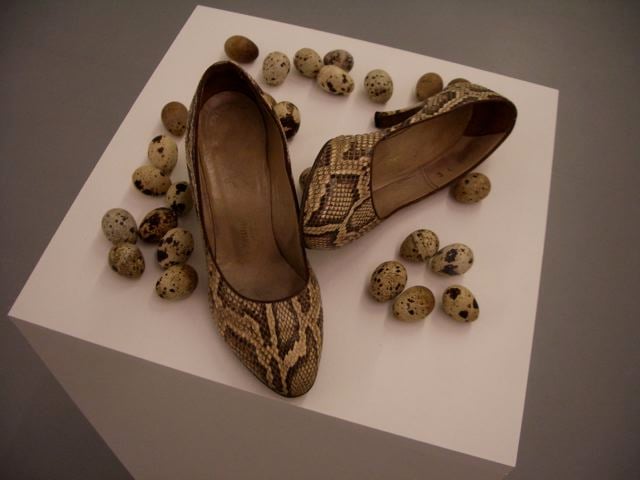Pair of shoes / Shoes with eggs
- Installation (Installation)
Hans-Peter Feldmann
The types of objects Feldmann is interested in collecting into serial photographic grids or artist’s books are often also found in three dimensional installations. Verging on a form of fetichism, his shoe collections are a case in point and indeed, for some exhibitions, he even asked gallery employees for their shoes. Against authorship and the commodification of art, he never gives titles or dates to his works which have infinite edition possibilities. The mode of display is paired down to the simplest form of a plain square plinth that nevertheless conveys artistry. The presentation contributes to the re-orientation and re-contextualization of these assembled found objects taken from everyday life. This work, like hat with photo and teapot with shadow also in the collection, could be imagined as a form suggestive of portraiture. Secondary autobiographical components are sometimes included: a set of eight black-and-white photographs of shoes, Ursula + Hans-Peter, stands for the artist and his wife with whom he worked in a gift store when he left the art world in the 1980s. The positioning of this female pair of shoes is clearly deliberate and meaningful as is the literal and playful mimetic association of snakeskin and quail’s eggs patterning.
Hans-Peter Feldmann creates intimate works that explore the link between art and entertainment. He does not date his projects, instead using the multiple as a snub to the art market and its suspicious sacralization. Rather than producing and inventing, he prefers to accumulate, recover, and collect. Feldmann assembles his findings, and collides them, letting the absurd and the poetic emerge. By giving images and objects back their strangeness, their tactile and emotional force, he expels the banal. His entire production questions the value of the artistic act. Through simple gestures and incongruous connections, Feldmann reminds us that art is an appropriation that populates our daily lives if we are willing to let it flourish.
Colors:
Other related works, blended automatically

© » KADIST
Hans-Peter Feldmann
The types of objects Feldmann is interested in collecting into serial photographic grids or artist’s books are often also found in three dimensional installations...

© » KADIST
Allen Ruppersberg
1970Untitled (City Limits) is a series of five black-and-white photographs of road signs, specifically the signs demarcating city limits of several small towns in California...

© » KADIST
Martin Kippenberger
19897″ Single ‘Pop In’ by Martin Kippenbergher consisting of a vinyl record and a unique artwork drawn by the artist on the record’s sleeve...

© » KADIST
Tony Labat
2008Commissioned by the San Francisco Museum of Modern Art and riffing on the “I Want You” army recruitment campaigns of the 1930s and 1940s, Labat asked Bay Area residents to interpret the slogan and make their own demands of the public in a series of live performance auditions...

© » KADIST
Andrew Grassie
2009In 2008, Grassie was invited by the Whitechapel Gallery to document the transformation of some of its spaces...

© » KADIST
Francis Alÿs
2004The Nightwatch , which is an ironic reference to the celebrated painting by Rembrandt, follows the course of a fox wandering among the celebrated collections of the National Portrait Gallery in London...

© » KADIST
Wolfgang Tillmans
2017Wolfgang Tillmans initiated the ongoing series Faltenwurf in 1989, representing compositions of unused clothing, with special attention paid to the ways in which they drape and fold...

© » KADIST
Ian Breakwell
2008“BC/AD” (Before Cancer, After Diagnoses) is a video of photographs of the artist’s face dating from early childhood to the month before he died, accompanied by the last diary entries he wrote from April 2004 to July 2005 (entitled “50 Reasons for Getting Out of Bed”), from the period from when he lost his voice, thinking he had laryngitis, through the moment he was diagnosed with lung cancer and the subsequent treatment that was ultimately, ineffective...

© » KADIST
Martin Kippenberger
1989Untitled is a work on paper by Martin Kippenberger comprised of several seemingly disparate elements: cut-out images of a group of dancers, a japanese ceramic vase, and a pair of legs, are all combined with gestural, hand-drawn traces and additional elements such as a candy wrapper from a hotel in Monte Carlo and a statistical form from a federal government office in Wiesbaden, Germany...

© » KADIST
Kota Ezawa
2014Paint and Unpaint is an animation by Kota Ezawa based on a scene from a popular 1951 film by Hans Namuth featuring Jackson Pollock...

© » KADIST
Martin Kippenberger
1988Martin Kippenberger’s late collages are known for incorporating a wide range of materials, from polaroids and magazine clips to hotel stationery, decals, and graphite drawings...

© » KADIST
Jeffrey Vallance
1978Vallance’s Rocket is a vibrant picture in which masses of color and collage coalesce into a central vehicle, yet the whole surface seems lit with the roar of space travel...

© » KADIST
Agnieszka Kurant
2022For Sentimentite Agnieszka Kurant collaborated with Justin Lane, CEO and Co-Founder of CulturePulse, to gather global sentiment data that has been harvested from millions of Twitter and Reddit posts related to 100 seismic events in recent history...

© » KADIST
Clemens von Wedemeyer
2003Silberhöhe , directed at Halle, located in the former GDR (German Democratic Republic), is the name of a neighborhood on the outskirts of the city, which was built in the 70’s and could accommodate more 40,000 people...

© » KADIST
Kota Ezawa
2017The Crime of Art is an animation by Kota Ezawa that appropriates scenes from various popular Hollywood films featuring the theft of artworks: a Monet painting in The Thomas Crown Affair (1999), a Rembrandt in Entrapment (1999), a Cellini in How to Steal a Million (1966), and an emerald encrusted dagger in Topkapi (1964)...





